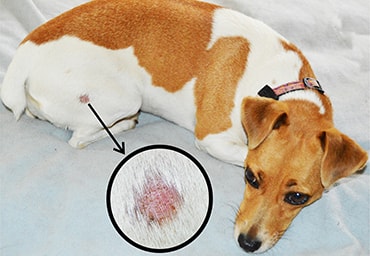Ringworm in dogs
Overview
- Ringworm is a fungal skin infection
- It causes hair loss and red, crusty skin (often in circular patches).
- Ringworm is very contagious and can easily spread to humans and other species.
- It can take several weeks to cure ringworm, but treatment is effective in most cases.
- Contact your vet if you think your dog has ringworm.
General information and causes
Despite its name, ringworm is not actually a worm and it isn't always ring shaped! It's a fungal infection that causes raised, crusty, hairless patches of skin, often in a ring-like pattern.
Ringworm doesn’t only infect dogs. It also affects, and spreads between humans and other animals such as cats, rodents, horses and cattle.
Ringworm is contagious. It can spread through direct contact, but can also live on surfaces such as bedding, towels and grooming equipment for up to two years.
Mild ringworm infections occasionally clear without treatment, but medical treatment is necessary for dogs with more serious infections. Puppies, older dogs, and dogs that are otherwise unwell are most at risk of serious ringworm infections.

A dog with ringworm
Symptoms of ringworm
Ringworm symptoms in dogs include:
- Patches of raised, red, crusty skin (often circular)
- Alopecia (fur loss)
- Dandruff
- Mildly itchy skin
Treatment
Treatment for ringworm can take a few weeks to work but is successful in most cases. Your dog is likely to need their coat clipped, a medicated shampoo and antifungal medication. It’s also important to disinfect your home and have any other pets checked by your vet.
- Coat clipping - clipping your dog’s fur (especially around their ringworm patches) will prevent the fungus spreading and help their medicated shampoo work.
- Medicated shampoo - you will need to give your dog an anti-fungal bath one to two times a week until their infection has fully cleared (this often takes a few weeks).
- Treatment by mouth - it’s possible that your dog will need a daily anti-fungal medicine by mouth (often for a month or more).
- Treating the house - ringworm can live in the environment for up to two years. During your dog’s treatment, you will need to decontaminate your household by regularly vacuuming, cleaning and washing bedding/soft furnishings.
Preventing spread
Ringworm in dogs isn’t as contagious as it is in cats, but until their infection has cleared up, it’s sensible to take precautions to prevent it spreading. Wear disposable gloves when handling and treating your dog, and if possible, try to keep them away from other pets in the house until they have recovered.
Outlook
It can take a few weeks to cure ringworm, but treatment is effective in most cases. However, ringworm can be persistent so you will need to keep an eye out for any returning symptoms. Some dogs develop ringworm when they are ‘run-down’ by another illness, so if your dog is struggling to recover, your vet may want to run some tests to investigate for other problems.
Can humans get ringworm?
Yes. Humans can catch ringworm in the same way animals can (from an animal, human or surface infected with ringworm). If you think you might have ringworm, contact your local health care services of the NHS for advice.
Cost
Treatment for ringworm can become very expensive because it often requires a several weeks of treatment, check-ups and tests. It’s important to speak openly to your vet about your finances, the cost of treatment, as well as what you think is right for your dog. There are often several treatment options so if one doesn’t work for you and your dog then the vet may be able to offer another.
When you welcome a new dog into your life, consider getting dog insurance straight away before any signs of illness start. This will give you peace of mind that you have some financial support if they ever get sick.
Published: August 2020
Did you find this page useful?
Tell us more
Please note, our vets and nurses are unable to respond to questions via this form. If you are concerned about your pet’s health, please contact your vet directly.
Thank you for your feedback
Want to hear more about PDSA and get pet care tips from our vet experts?
Sign up to our e-newsletter
Written by vets and vet nurses. This advice is for UK pets only. Illustrations by Samantha Elmhurst.

